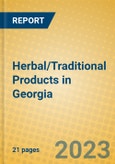In 2024, the growth of herbal and traditional products in Georgia is supported by increased consumer interest in dietary supplements and cough treatments. This growth is facilitated by a broader range of herbal and traditional options available within these segments However, the selection of herbal and traditional products remains relatively modest compared to the continually expanding range of non-herbal and traditional offerings.
The Herbal/Traditional Products in Georgia report offers a comprehensive guide to the size and shape of the market at a national level. It provides the latest retail sales data 2019-2023, allowing you to identify the sectors driving growth. Forecasts to 2028 illustrate how the market is set to change.
Product coverage: Herbal/Traditional Cough, Cold and Allergy (Hay Fever) Remedies, Herbal/Traditional Dermatologicals, Herbal/Traditional Dietary Supplements, Herbal/Traditional Digestive Remedies, Herbal/Traditional Paediatric Dietary Supplements, Herbal/Traditional Sleep Aids, Herbal/Traditional Tonics, Herbal/Traditional Topical Analgesics.
Data coverage: Market sizes (historic and forecasts), company shares, brand shares and distribution data.
The Herbal/Traditional Products in Georgia report offers a comprehensive guide to the size and shape of the market at a national level. It provides the latest retail sales data 2019-2023, allowing you to identify the sectors driving growth. Forecasts to 2028 illustrate how the market is set to change.
Product coverage: Herbal/Traditional Cough, Cold and Allergy (Hay Fever) Remedies, Herbal/Traditional Dermatologicals, Herbal/Traditional Dietary Supplements, Herbal/Traditional Digestive Remedies, Herbal/Traditional Paediatric Dietary Supplements, Herbal/Traditional Sleep Aids, Herbal/Traditional Tonics, Herbal/Traditional Topical Analgesics.
Data coverage: Market sizes (historic and forecasts), company shares, brand shares and distribution data.
Why buy this report?
- Get a detailed picture of the Herbal/Traditional Products market;
- Pinpoint growth sectors and identify factors driving change;
- Understand the competitive environment, the market’s major players and leading brands;
- Use five-year forecasts to assess how the market is predicted to develop.
Table of Contents
KEY DATA FINDINGSCONSUMER HEALTH IN GEORGIADISCLAIMERDEFINITIONS
2024 DEVELOPMENTS
PROSPECTS AND OPPORTUNITIES
CATEGORY DATA
EXECUTIVE SUMMARY
MARKET INDICATORS
MARKET DATA
APPENDIX
SOURCES








